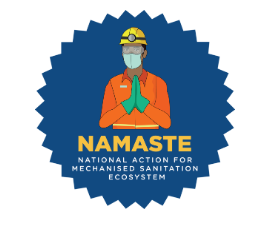NAMASTE Scheme (GS Paper 2, Government Policies)

Introduction
- Manual scavenging remains a deeply entrenched issue in India, where caste-based discrimination continues to influence occupational choices.
- The National Action for Mechanised Sanitation Ecosystem (NAMASTE) scheme, recently highlighted in government data, aims to eradicate this practice by focusing on the safety and dignity of sanitation workers.
- Recent statistics reveal that a staggering 92% of the approximately 38,000 manual scavengers in urban areas belong to Scheduled Castes (SCs), Scheduled Tribes (STs), or Other Backward Classes (OBCs), underscoring the urgent need for systemic change.
What is Manual Scavenging?
- Manual scavenging involves the manual handling of human excreta, often from unsanitary latrines, open drains, or railway tracks.
- Despite being banned under the Prohibition of Employment as Manual Scavengers and Their Rehabilitation Act (PEMSR) of 2013, the practice persists due to socio-economic factors, lack of alternative employment, and the deeply rooted caste hierarchy in India.
- The Act defines manual scavengers as those engaged in cleaning human waste, categorizing this work as dehumanizing and harmful.
The NAMASTE Scheme: Objectives and Goals
Launched as a joint initiative by the Ministry of Social Justice and Empowerment (MoSJE) and the Ministry of Housing and Urban Affairs (MoHUA), the NAMASTE scheme aims to transform the sanitation landscape in India. Key components of the scheme include:
- Profiling of Workers: The initiative involves detailed profiling of Sewer/Septic Tank Workers (SSWs) to create a comprehensive database that informs policy and funding.
- Safety Training and Equipment: The scheme provides training in occupational safety and supplies personal protective equipment (PPE) to SSWs, significantly reducing the health risks associated with hazardous cleaning tasks.
- Health Insurance: Under the Ayushman Bharat Pradhan Mantri Jan Arogya Yojana (AB-PMJAY), workers will receive health insurance coverage, ensuring access to healthcare services.
- Sanipreneurship Development: The scheme encourages the transition of sanitation workers into "sanipreneurs," promoting self-employment through the provision of capital subsidies and skill development.
By 2025-26, NAMASTE aims to cover over 4,800 Urban Local Bodies (ULBs), transforming the way sanitation work is approached and executed in India.
Challenges in Addressing Manual Scavenging
The persistence of manual scavenging can be attributed to several interconnected challenges:
- Caste-Based Discrimination: The caste system places Dalits at the bottom of the social hierarchy, linking them with polluting tasks like manual scavenging. This social stigma perpetuates marginalization and exploitation.
- Insufficient Awareness: Many officials lack a clear understanding of what constitutes manual scavenging, leading to hidden data and inadequate support for affected individuals.
- Inadequate Infrastructure: India’s sewage and drainage systems remain underdeveloped, necessitating manual intervention. Many urban areas still rely on insanitary latrines, perpetuating the need for manual scavenging.
- Weak Enforcement of Laws: Although laws exist to prohibit manual scavenging, enforcement is often lax. Employers who engage manual scavengers frequently face no penalties, allowing the practice to continue unchallenged.
- Social Stigma and Economic Barriers: Those attempting to leave manual scavenging often face threats, violence, and community ostracism, which reinforces their dependence on this degrading work.
Government Initiatives and Legislative Framework
The Indian government has introduced various initiatives to combat manual scavenging, including:
- Prohibition of Employment as Manual Scavengers and Their Rehabilitation Act, 2013: This comprehensive law seeks to eliminate manual scavenging by mandating the rehabilitation of affected individuals and prohibiting the construction of insanitary latrines.
- Rashtriya Garima Abhiyaan: This national campaign focuses on the eradication of manual scavenging and the promotion of dignity and rehabilitation for manual scavengers.
- Self Employment Scheme for Rehabilitation of Manual Scavengers: This initiative provides assistance for manual scavengers to transition into self-employment, helping them escape the cycle of poverty and discrimination.
Moving Forward: Strategies for Change
To effectively combat manual scavenging and facilitate rehabilitation, the following strategies should be prioritized:
- Link Rehabilitation to Social Security: Integrating rehabilitation programs with existing social security measures, such as the Mahatma Gandhi National Rural Employment Guarantee Act (MNREGA), can provide affected communities with access to stable employment and livelihoods.
- Enhance Coordination Among Agencies: Establishing inter-ministerial coordination can facilitate a comprehensive and unified approach to eliminating manual scavenging. Engaging NGOs and community organizations can also strengthen enforcement of existing laws at the grassroots level.
- Invest in Infrastructure: Allocating resources to develop modern sewage systems and drainage infrastructure is critical to reducing the reliance on manual scavenging. This investment will help prevent the need for hazardous cleaning practices in the first place.
- Community Awareness Programs: Conducting awareness campaigns to educate both sanitation workers and the wider community about the dignity of labor can help combat the stigma associated with sanitation work. Education can empower workers and encourage community support for their rights.
- Regular Monitoring and Audits: Implementing robust auditing mechanisms to ensure compliance with laws and effectiveness of initiatives like NAMASTE is essential. A national-level monitoring committee can oversee the implementation of programs and address systemic issues.
Conclusion
- The NAMASTE scheme represents a pivotal step towards abolishing manual scavenging and improving the livelihoods of sanitation workers in India.
- By addressing systemic issues related to caste discrimination, enhancing infrastructure, and promoting awareness, India can create a more equitable society where all workers are treated with dignity and respect.
- The success of this initiative hinges on the collective efforts of government, civil society, and communities to build a just and inclusive future for all.


